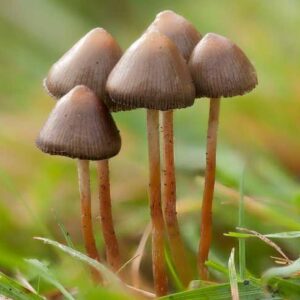Description
Psilocybe Cubensis Mushrooms For Sale | Psilocybe Cubensis Dried
Psilocybe cubensis mushroom is currently one of the most popular and commonly available natural psychedelics. This species is known under several other names such as Stropharia cubensis, Stropharia cyanescens or Stropharia caerulescens, often referred to as the ‘Mexican mushroom’, and popularly known as magic mushrooms or shrooms. This mushroom is relatively easy to grow, and therefore it is one of the most widely used hallucinogenic mushrooms all over the world. In smartshops, they are often called ‘magic mushrooms’.
If you’ve eaten psilocybin mushrooms, but had no idea what species it was, chances are it was a strain of Psilocybe cubensis. That’s because “cubes” are the easiest magic mushroom to cultivate indoors, and since the 1970s, there have been a few pivotal books teaching hobby growers how to do so, including Terence and Dennis McKenna’s, Psilocybin: The Magic Mushroom Grower’s Guide. In fact, due to decades of selective home breeding, there are now 60 different strains of P. cubensis, like Golden Teachers, B+mushrooms, Penis Envy, and Pink Buffalo.
EFFECTS OF THE Psilocybin CUBENSIS ‘MAGIC MUSHROOM’
The historical mind-altering effects of psilocybin are described as a voyage to the spirit world. These hallucinogenic effects are similar to those of LSD; however, psilocybin is two hundred times less potent and also has a shorter duration time (Schwartz 1988). Common physiological reactions include muscular relaxation, coldness of the limbs and abdomen, and dilation of the pupils. A somewhat stronger dose includes vision and mental hallucinations, powerful distortion of space, increased ability to visualize creatively, spontaneous detailed images, feelings of time distortion. These effects of psilocybin are often more pronounced in users who have used mushrooms before. So, the use of the b+ mushrooms causes a feeling of disconnection from reality and an altered state of consciousness (Cumno 1994).
The nature of this trip depends on the person taking it and the mood/state of mind that person is in. So your experience can be quite different from what you can read here or hear from other people.
At first, there might occur some side effects; unlike a hangover from alcohol afterwards, mushrooms give sort of a hangover before the actual trip starts. This includes a feeling of reduced temperature, gas and/or stomach discomfort and nausea. This is where a bad trip could start, remember this only happens when you come to think negative about it, these feelings then become stronger and exaggerated and this negative spiral influences the effects in the same way. This is more likely to happen to people who have a history of being depressed, schizophrenic or traumatized. So if you suffer from one of these, but also if you feel stressed, tensed or just not happy, do not take b+ mushrooms.
When taking a medium dose the trip takes about 4 – 6 hours and wears down gradually. The interval between hallucinations gets longer until they disappear completely.
MEDICAL USE
The prevalence of psilocybin throughout history and its current use has led to intensive studies and research. The studies on human and animal models both demonstrated that psilocybin produces temporary psychosis-like symptoms primarily through serotonin-2 receptor stimulation.
Very positive effects are reported by people suffering from cluster headaches; their pains are reduced extremely thanks to the use of some varieties of Psilocybe cubensis. Erowid has gathered information and experiences on this.
Research has also demonstrated that psychoactive mushrooms when taken under professional supervision, can be helpful in the treatment of mental disorders.Research on this matter is still going on and safety parameters still have to be established.
Detection of Fungal Hallucinogens Such as Psilocybin and Psilocin
Methods applicable to the detection of hallucinogenic indole compounds, namely psilocybin, psilocin, and related molecules, that have been developed so far for purposes of mycological research, toxicological studies, or forensic investigations are described in this chapter. The most current literature as well as some interesting older publications are cited, providing a historical overview of the subject. Methods of qualitative and quantitative analysis are presented. Additionally, preliminary purification steps and sample treatment before the exact quantitative determination are proposed. The methods described utilized various analytical techniques for the measurement of psilocybin/psilocin content in the analyzed material, including capillary electrophoresis, chemiluminescence detection systems, high-performance liquid chromatography with electrochemical, ultraviolet, or fluorescence detection systems, gas chromatography, and liquid chromatography coupled with mass spectrometry. The methods developed for simultaneous determination of several commonly abused psychoactive substances along with psilocin/psilocybin are also mentioned.






Reviews
There are no reviews yet.